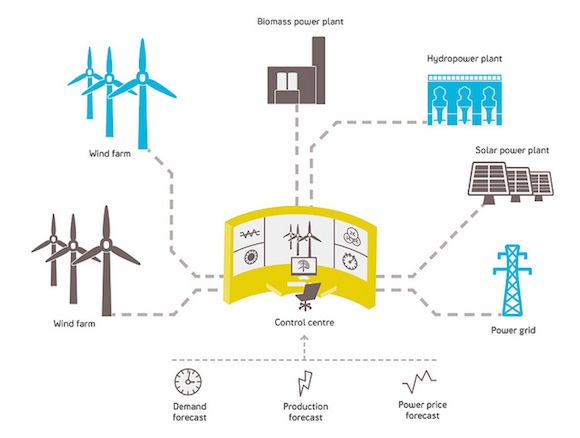What is a "virtual power station"?
The energy transition is bringing a wave of new jargon into the public realm. This section provides some background on the most important ones, with this week’s edition focusing on "virtual power stations". Unlike conventional power stations, virtual power stations consist of several generating installations, load or storage facilities that aggregate electricity and feed it into the grid in a controlled fashion. Virtual power stations therefore play an important role in making the energy transition a success.
 © BMWi; Statkraft Markets GmbH
© BMWi; Statkraft Markets GmbH
Renewable energy sources such as wind, solar and biomass already account for nearly one third of Germany’s electricity consumption. This clearly indicates that the energy reforms are making good progress. However, the transition from conventional energy sources such as coal and gas to renewables also involves some challenges. Electricity no longer comes from a few large-scale power stations, but from countless small-scale installations all over the country. There are also sharp fluctuations in electricity fed in from renewables. In times when there is a lot of wind and sun, production will be high; at night or when there is no wind, production will be low. However, households and industry need a reliable electricity supply at all times.
Renewable energy gains more independence
Up to now, conventional power stations step into the breach in times when wind, solar or biomass are unable to meet electricity demand. In the future, however, renewables will have to be able to deliver a reliable electricity supply, especially as their share in the overall energy mix is to grow. A secure and reliable electricity supply can only be guaranteed if the electricity grid is stable – this means that at all times just as much power is fed into the electricity grid as is taken off it.
This is where "virtual power stations" (sometimes called "aggregators") come in. Like a control centre, they aggregate electricity from several small-scale generators and feed in exactly as much electricity as has been purchased.
What may seem easy at first actually requires a lot of planning and controlling. To predict the amount of electricity a virtual power plant can feed into the grid as exactly as possible, the amount of electricity available from generators that are part of the cluster has to be assessed. A monitoring system is required to track every single generator in real-time, to know exactly which installations are turned on and ready for operation and how much electricity each of them can provide at a given moment. For example, to predict the exact amount of electricity solar and wind power installations can generate, weather conditions have to be taken into account.
Working together for more flexibility
The amount of electricity a virtual power station can generate varies. If the amount available from one installation of the virtual power station is higher or lower than predicted, adjustments have to be made. This is possible – thanks to so-called dispatchable power generators, such as generating installations, demand or storage facilities.
An important task fulfilled by virtual power stations is that they sell the electricity produced by the generators of the cluster. The reason for this is that since August 2014, operators of renewable energy installations with an output of more than 500 kilowatts have to sell the electricity they don’t use themselves. From 2016 on, this rule will apply to all installations with an output of 100 kilowatts or higher. The virtual power station takes care of selling the electricity from connected generators on the exchange. It therefore has to control every single system, ensuring that the electricity that is fed into the grid matches the exact amount that was sold.
Ensuring system security
To ensure that electricity is available at all times, so-called ancillary services are needed, for example, to stabilise frequency and voltage in the electricity grid. Virtual power stations can make a contribution to this as well, for example by providing balancing capacity for frequency control. The "Kombikraftwerk 2" project has already confirmed this successfully.
The power station of the future
Some virtual power stations are already up and running, Next Kraftwerk GmbH’s "Next Pool" for example, or the virtual power station set up by Statkraft. Together, these two power stations can access almost 10,000 megawatts of electricity – this corresponds to the output of ten nuclear reactors. Some other virtual power stations also integrate storage facilities or flexible loads in the cluster of different electricity installations or already deliver ancillary services. This makes them an important part of the energy transition, contributing to a secure electricity supply.

